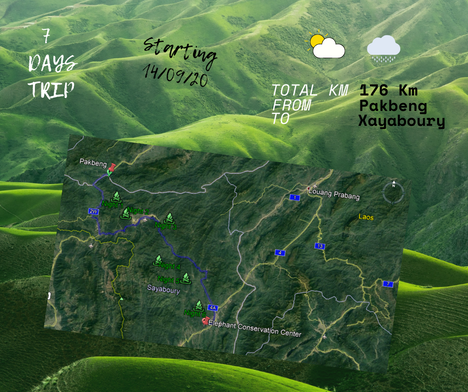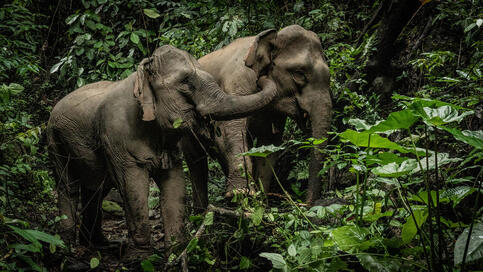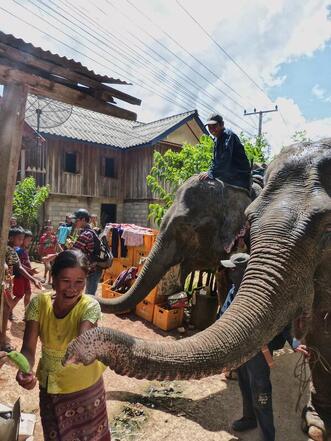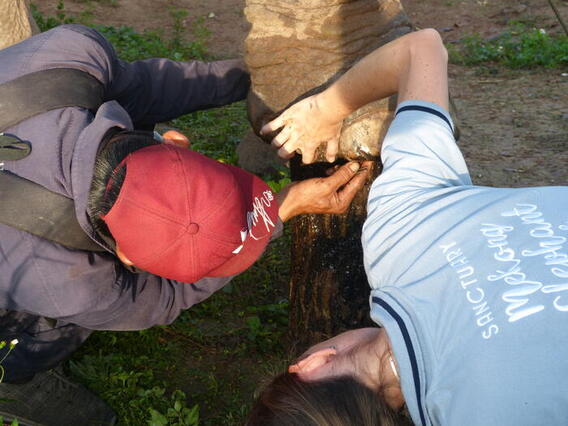As Laos’ border is still closed at the moment, our manager Wendy has decided to take advantage of this quiet time to move forward with Mae Bounma and Mae Ping’s reproduction project.
As it has not been working so far with our male, our two youngest females, Mae Ping and Mae Bounma were heading to the Elephant Conservation Center located within a week’s walking distance from the Mekong Elephant Park.

The Elephant Conservation Center has offered their help to host our two females at their facility for a few months, where they have more breeders, and a professional biologist team to monitor and analyze our elephants’ cycles. Wendy, our 3 mahouts Mr. Saw, Mr.Kong and Mr. Singh embarked on a 7-day (later turned into 8-day) walk through the forests and villages to ensure a safe and sound arrival of Mae Ping and Mae Bounma to the ECC.
ECC is a renowned elephant sanctuary located in the Xayaboury Province that is constantly sharing its knowledge and expertise with us and will be mentoring all the process. We started our breeding program one year ago in partnership with them to prevent the progressive extinction of this animal.

The first step was to find Mae Ping and Mae Bounma’s reproduction cycle. The female is fertile for approximatively three days every four months, the gestation period is aprox 2 years and can give birth around once every five years. In the wild males and females easily detect these periods but unfortunately this is not the case with our elephants. Confronted with the decline in the number of elephants in Laos, being capable of predicting future cycles is essential.
The second step will be to find a good breeder and for the female to accept him!
Mae Ping and Mae Bounma’s Great Adventure
Our 8-day trip with Mae Ping and Mae Bounma from the Mekong Elephant Park in Pakbeng to the Elephant Conservation Center in Sayaboury was truly an adventure, filled with challenges and surprises.
In the beginning, the trip was very physical as we had to cross Hmong (minority tribe) villages, where there were hardly any tracks to follow. We often had to start our days at 4am to avoid the miday heat and make it easier to climb the hills in the cool of the morning.
In the second part of our journey, the rainy season finally arrives and we got to discover the lush beauty of Laos in the best time of the year. We travelled through beautiful green rice paddies and corn fields. We were warmly welcomed by the generous local families and children.
We were able to eat and sleep within the forest thanks to our dedicated mahouts. They have grown up in the forest and, therefore, finding food and setting up camps to spend the night are second nature to them.
We went through many villages that, 20 years ago, used to house generations of children and elephants living together. Unfortunately, with the declining population of elephants, the new generation haven’t had the opportunity to meet them. Our passing journey was their first chance to encounter real life elephants.

We took this opportunity to inform young people about the current situation of elephants in Laos, in order to encourage them to protect the elephants and the forest.
And because a real adventure is always unpredictable, we encountered our biggest challenge on day 6, when Mae Ping woke up limping badly. Our best guess was that something had happened during the night, as she’s shown no sign of a problem the day before. We gave 2 full day of resting but she didn’t get better, and with a heavy storm heading our way from Vietnam with strong winds, heavy rains, and possible landslides…

…we decided for Mae Ping and Mae Bounma to finish the last 60km of the journey in a lorry. It took us 4 hours instead of 2 days. This was our 2 elephants’ first time in a truck. Overcoming this challenge, we finally made it to the Elephant Conservation Center safe and sound, and our journey was altogether a very unique experience.
A few days after our arrival, Mae Ping’s foot was no longer swollen and she wasn’t suffering anymore. It would appear that something had entered between the two toes and came out almost immediately, leaving only swelling visible.

